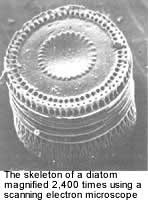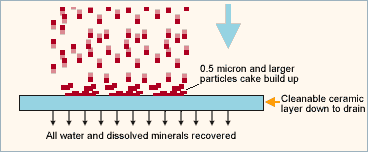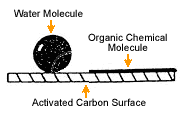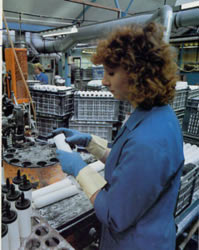 Doulton
mines only the finest and purest kieselguhr or
diatom earth often described as a
silica-like sediment resulting from kiesel algae (one celled
algae) deposited on the bottom of geological lakes and lagoons
millions of years ago. This is the same material used in making
the finest bone china (like of Royal Doulton) and numerous other
applications.
Doulton
mines only the finest and purest kieselguhr or
diatom earth often described as a
silica-like sediment resulting from kiesel algae (one celled
algae) deposited on the bottom of geological lakes and lagoons
millions of years ago. This is the same material used in making
the finest bone china (like of Royal Doulton) and numerous other
applications.
 Doulton
filter elements are produced using the latest ceramic techniques
to provide a hollow porous ceramic which is fired at a
temperature in excess of 1000°C. The chemically inert ceramic
filter can be stored for eternity without losing its
effectiveness.
Doulton
filter elements are produced using the latest ceramic techniques
to provide a hollow porous ceramic which is fired at a
temperature in excess of 1000°C. The chemically inert ceramic
filter can be stored for eternity without losing its
effectiveness.
Doulton ceramic candles filter particles
from the water but leaves oxygen and mineral contents unchanged,
which gives water it's spring-like freshness and taste (not
"pure" but wholesome). Pathogens of the most varied diseases
which are reliably filtered from the water include; cholera,
typhus, cryptosporidium, amoebic dysentery, ecoli, colibacillose
or bilharzia, anthrax spores among others.
The porous structure of the filter allows the passage of water;
particles and very small bacteria are held back at the filter
surface. The result is clear, sterilized water.
Given favourable conditions, the accumulated bacteria could
proliferate and grow unless prevented by some means.
To prevent this Doulton elements
(except the Standard, Ceracarb and Ceramet) are manufactured
with a small amount (about 0.07%) of pure silver (Ag)
through-out the porous ceramic shell. Silver is a recognized
bactericide, so when the bacteria comes into contact with the
silver impregnated ceramic, their growth is inhibited. This
self-sterilizing effect is known as the bacteriostatic
effect.
 Mechanical
regeneration of the ceramic filter is simple. The topmost
blocked layer can be removed with
stiff brush or scouring pad (e.g. Scotch Brite®). This can be
repeated many times before the filter has to be changed.
Mechanical
regeneration of the ceramic filter is simple. The topmost
blocked layer can be removed with
stiff brush or scouring pad (e.g. Scotch Brite®). This can be
repeated many times before the filter has to be changed.
Silver, a nature's water purifier
(I.E. click refresh button to see silver animation)

Free silver ions (Ag+) have a
toxic effect on micro-organisms even in relatively low
concentrations. They have a highly fungicidal, bactericidal and
algaecidel effect. Medical studies describe silver ions a
catalyst that disable the enzymes that microorganisms depend on
to "breathe".
In the presence of air (oxygen in water), metallic silver forms
silver oxide, which also has a bactericidal effect due to its
adequate solubility. The destruction of viruses, bacteria,
moulds, spores and fungi through contact with silver objects is
termed the oligodynamic effect. To primitive
life forms, oligodynamic silver is as toxic as the most powerful
chemical disinfectants. This, coupled with its relative
harmlessness to animate life (i.e. mammals), gives oligodinamic
silver great potential as a disinfectant.
The best and most
environmentally-friendly silver based disinfectants are capable
of rendering stored water potable for long period of time as in
space stations.
The silver leach rate from the Doulton ceramic is very low and
always well below the national recommended limits or equivalent
to having a meal using silver cutlery.
Do Doulton
ceramic filter removes viruses?
Due to their tiny size viruses theoretically cannot be
removed with a 0.2 micron or higher rated
absolute filter (or any mechanical
filter for that matter). If virus is a concern simply add a
commercially available disinfectant such as silver (e.g.
Katadyn's Micropur®) or iodine tablets. Doulton Supersterasyl
candle will remove the unpleasant taste and odours of the
iodine.
Physically viruses have
electrical surface charge that attaches them to other larger
particles (free ride). The tight pore-structure of any absolute
sub-micron water filter (e.g. Doulton, Katadyn etc.) can remove
"free ride" viruses however due to many variables no device
should be relied upon viral control.
Activated carbon as another
natural adsorber

 Doulton
uses high quality carbon blends obtained from different raw
materials such as lignite, bituminous coal and coconut shells.
Active carbon is used for water treatment due to its
adsorbing effect with respect to organic and health
endangering chemicals.
Doulton
uses high quality carbon blends obtained from different raw
materials such as lignite, bituminous coal and coconut shells.
Active carbon is used for water treatment due to its
adsorbing effect with respect to organic and health
endangering chemicals.
 Activated
carbon surfaces are both hydrophobic and
oleophilic; that is, they “hate” water but
“love” oil. When flow conditions are suitable, dissolved
chemicals in water flowining through the carbon media “stick” to
the carbon surface in a thin film while the water passes on.
This process is call adsorption.
Activated
carbon surfaces are both hydrophobic and
oleophilic; that is, they “hate” water but
“love” oil. When flow conditions are suitable, dissolved
chemicals in water flowining through the carbon media “stick” to
the carbon surface in a thin film while the water passes on.
This process is call adsorption.
Substances affecting taste and
odours such as chlorine, pesticides (lindane, DDT) and
trihalogenmethanes (THMs) are removed by activated carbon. These
substances are adsorbed on the large surface area of the active
carbon. For visual purpose, one teaspoon of activated carbon
have a surface area the size of a football field.
Active carbon is available in
granulate
(GAC filters), powder
(PAC filters) or extruded solid carbon block form
(CB filters).
Doulton
Ceramic Candles and Cartridge Grades
 Sterasyl membrane: (candle and cartridge form):
Used for microbiological removal. The only ceramic element in
the world to meet the stringent NSF antimony and arsenic
extraction test featuring:
Sterasyl membrane: (candle and cartridge form):
Used for microbiological removal. The only ceramic element in
the world to meet the stringent NSF antimony and arsenic
extraction test featuring: